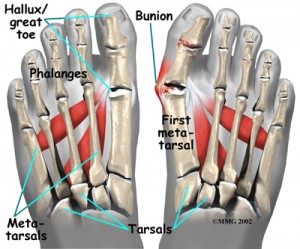What is Foot Deformity Surgery?
 A bunionectomy is a surgical procedure to excise, or remove, a bunion. A bunion is an enlargement of the joint at the base of the big toe and is comprised of bone and soft tissue. It is usually a result of inflammation and irritation from poorly fitting (narrow and tight) shoes in conjunction with an overly mobile first metatarsal joint and over-pronation of the foot. Over time, a painful lump appears at the side of the joint, while the big toe appears to buckle and move sideway towards the second toe. New bone growth can occur in response to the inflammatory process, and a bone spur may develop. Therefore, the development of a bunion may involve soft tissue as well as a hard bone spur. The intense pain makes walking and other activities extremely difficult. Since the involved joint is a significant structure in providing weight-bearing stability, walking on the foot while trying to avoid putting pressure on the painful area can create an unstable gait.
A bunionectomy is a surgical procedure to excise, or remove, a bunion. A bunion is an enlargement of the joint at the base of the big toe and is comprised of bone and soft tissue. It is usually a result of inflammation and irritation from poorly fitting (narrow and tight) shoes in conjunction with an overly mobile first metatarsal joint and over-pronation of the foot. Over time, a painful lump appears at the side of the joint, while the big toe appears to buckle and move sideway towards the second toe. New bone growth can occur in response to the inflammatory process, and a bone spur may develop. Therefore, the development of a bunion may involve soft tissue as well as a hard bone spur. The intense pain makes walking and other activities extremely difficult. Since the involved joint is a significant structure in providing weight-bearing stability, walking on the foot while trying to avoid putting pressure on the painful area can create an unstable gait.
Purpose of Bunionectomy
A bunionectomy is performed when conservative means of addressing the problem, including fitting, wide-toed shoes, a padded cushion against the joint, orthotics, and anti-inflammatory medication, are unsuccessful. As the big toe moves sideways, it can push the second toe sideways as well. This can result in extreme deformity of the foot, and the patient may complain not only of significant pain, but of an inability to find shoes that fit.
How Bunionectomy surgery done
Bunions become more common later in life. One reason is that with age the foot spreads and proper alignment is not maintained. In addition, the constant friction of poorly fitting shoes against the big toe joint creates a greater problem over time. Ignoring the problem in its early stages leads to a shifting gait that further aggravates the situation.
Once surgery has been decided on, the extent of the procedure will depend on the degree of deformity that has taken place. There are several different surgical techniques, mostly named after the surgeons who developed them, such as McBride, Chevron, and Keller. The degree and angle of deformity as well as the patient’s age and physical condition play a significant role in the surgeon’s choice of technique, which will determine how much tissue is removed and whether or not bone repositioning will occur. If bone repositioning is done, that part of the surgery is referred to as an osteotomy ( osteo means bone). The type of anesthesia, whether ankle block (the most common, in which the foot is numb but the patient is awake), general, or spinal, will depend on the patient’s condition and the anticipated extent of the surgery. For surgery done on an ambulatory basis, the patient will usually be asked to arrive one to two hours before the surgery and stay for about two to three hours after the procedure. The procedure itself may take about an hour.
The surgeon will make an incision over the swollen area at the first joint of the big toe. The enlarged lump will be removed. The surgeon may need to reposition the alignment of the bones of the big toe. This may require more than one incision. The bone itself may need to be cut. If the joint surfaces have been damaged, the surgeon may hold the bones together with screws, wires, or metal plates. In severe cases, the entire joint may need to be removed and a joint replacement inserted. If pins were used to hold the bones in place during recovery, they will be removed a few weeks later. In some mild cases, it may be sufficient to repair the tendons and ligaments that are pulling the big toe out of alignment. When finished, the surgeon will close the incision with sutures and may apply steri-strips as an added reinforcement. A compression dressing will be wrapped around the surgical wound. This helps to keep the foot in alignment as well as help reduce postoperative swelling.





